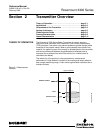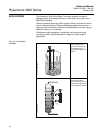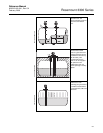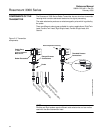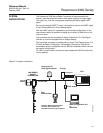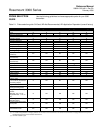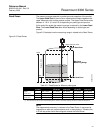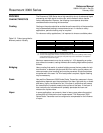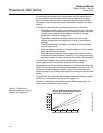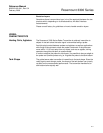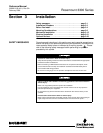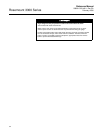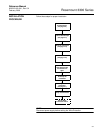
Reference Manual
00809-0100-4811, Rev CA
February 2006
Rosemount 3300 Series
2-8
PROCESS
CHARACTERISTICS
The Rosemount 3300 Series has a high sensitivity due to its advanced signal
processing and high signal to noise ratio, which makes it able to handle
various disturbances. However, the following circumstances should be
considered before mounting the transmitter.
Coating Coating on the probe should be avoided since the sensitivity of the transmitter
may be decreased leading to measurement errors. In viscous or sticky
applications, periodic cleaning may be required.
For viscous or sticky applications, it is important to choose a suitable probe:
Table 2-3. Probe type guide for
different product viscosity
Maximum measurement error due to coating is 1-10% depending on probe
type, dielectric constant, coating thickness and coating height above product
surface.
Bridging Heavy coating that results in product bridging across the two probes for twin
lead versions, or between the pipe and the inner rod for coaxial probes, will
cause erroneous level readings and must be prevented. Single lead probes
are preferred in this case. If a Twin Lead probe is required, regular cleaning
may be necessary.
Foam How well the Rosemount 3300 Series Radar Transmitter measures in foamy
applications depends upon the properties of the foam; light and airy or dense
and heavy, high or low dielectrics, etc. If the foam is conductive and creamy
the transmitter will probably measure the surface of the foam. If the foam is
less conductive the microwaves will probably penetrate the foam and
measure the liquid surface.
Vapor In some applications, as ammonia, there is heavy vapor above the product
surface that will influence the level measurement. The Rosemount 3300
Series Radar Transmitter can be configured to compensate for the influence
of vapor.
Coaxial Twin Lead Single Lead
Maximum viscosity
500 cP 1500 cP 8000 cP
(1)(2)
(1) Consult factory if agitation/turbulence and high viscous products.
(2) HTHP and HP single probes should be used with precaution in viscous or crystallizing media. Cooling
of high temperature vapor in the upper part of the probe may lead to condensation and deposition
that blocks the measurement signal.
Coating/Build-up
Coating not recommended Thin coating allowed, but no
bridging
Coating allowed




